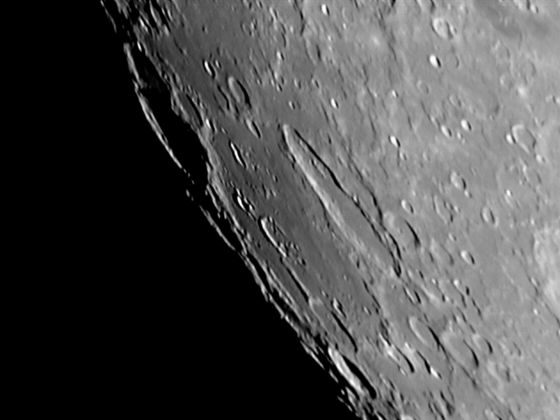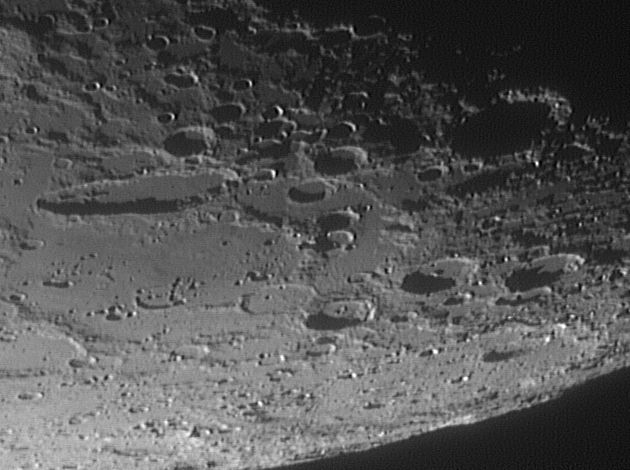

Move your mouse over the picture to see the names of the various craters.

This area is just to the south of Schickard. The most prominent feature is Schiller,
a genuinely elliptical crater 184 Km long and 43 Km wide with a depth of 3900 metres. It may
have been formed by the fusion of two circular craters or possibly by a grazing impact.
Either way, it was formed about 3,900 million years ago. The floor is very flat to the
south-east but much more tormented to the north-west.
The scale markers are 100 Km north, east, and approximately in the direction of minimum scale.
The picture was taken with a ToUcam attached to my LX200 on 25th October 2004 at 22:28 UT,
when the Moon was 12.6 days old.
A mosaic of this picture and one to the north and one to the south can be seen here.
Date and Time: 25th October 2004 at 22:28 UT
Camera: ToUcam 740K
Telescope: LX200 at prime focus (FL 2500 mm)
Capture: K3CCDTools. High gamma, 1/500", 0% gain, 310 frames
Processing: Registax. 57 frames stacked. Wavelet 1,2 = 10

Another picture of Schiller, this time in infra-red light with the light coming from the other direction.
Unfortunately this picture is tilted rather badly, but the scale markers show which way is north.
I have gone to town somewhat in labelling the minor craters in this picture, but it never ceases
to intrigue me when I find lettered craters referring to larger craters which are not the nearest large crater
(like Schiller C here which is very close indeed to Phocylides A).
The LPOD for 12 May 2004 pointed out that there is evidence for a very old 3-ringed impact basin here, discovered by Bill Hartmann and Gerard Kuiper in the 1960s. Using the LPOD as a guide, I have attempted to show the three rings with dashed lines in the mouseover.
The picture was taken in infra-red light with a ToUcam attached to my LX200 on 29th August 2005 at 04:47 UT,
when the Moon was 24.5 days old.
The scale markers are approximately 100 Km north and east.
Date and Time: 29th August 2005 04:47 UT
Camera: ToUcam 740K with IR-pass filter
Telescope: LX200 at prime focus (FL 2500 mm)
Capture: K3CCDTools. Mid gamma, 1/25", 53% gain, 339 frames
Processing: Registax. 138 frames stacked. Wavelets 1 = 10, 2 = 5, histogram 0-200 Home Back to SW Quadrant